 W
WAfrican military systems (1800–1900) refers to the evolution of military systems on the African continent after 1800, with emphasis on the role of indigenous states and peoples within the African continent. Only major military systems or innovations and their development after 1800 are covered here. For events prior to 1800, see African military systems to 1800. Coverage of the 20th century and beyond is provided in African military systems after 1900. For an overall view of the military history of Africa by region, see Military History of Africa. See individual battles, empires and leaders for details on activities after 1800.
 W
WAs the 20th century began, most of Africa, with the exception of Ethiopia, Somalia and Liberia, was under colonial rule. By the 1980s, most nations were independent. Military systems reflect this evolution in several ways:Growth of indigenous knowledge and skill in handling modern arms Established colonial armies of mainly indigenous troops officered by Europeans Rebellions, resistance and "mop up" operations Weakening of European colonial power due to World War I and World War II Decolonization and the transition to the militaries of the new African states Wars of national liberation across the continent particularly the northern and southern regions Frequent tribal or civil wars across the continent Frequent military coups against the post colonial regimes Continued strength of regional powers like Egypt and South Africa The rise of asymmetric forces and failed states The rise of international forces and bureaucracies Continued challenges and evolution into the 21st century
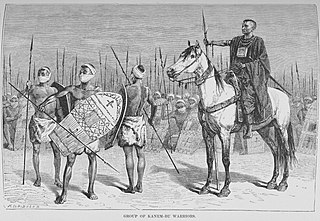 W
WAfrican military systems to 1800 refers to the evolution of military systems on the African continent prior to 1800, with emphasis on the role of indigenous states and peoples, whose leaders and fighting forces were born on the continent, with their main military bases, fortifications, and supply sources based on or deriving from the continent, and whose operations were conducted within the continental mass or close to its borders or coasts. Development of the military arts in this framework generally moved from the simple to the more sophisticated as economies and cultures became more elaborate. Areas such as Carthage, Egypt and Nubia are reflected in the antiquarian period. The pre-colonial period also saw a number of military systems- from cavalry empires on the grasslands, to kingdoms in more tropical and forested areas. The emergence of the gunpowder era, alongside developments in indigenous organization and culture, was to spark far-reaching consequences cutting across all regions, with ripple effects in culture, politics and economies.
 W
WThe African Theatre of the First World War comprises campaigns in North Africa instigated by the German and Ottoman empires, local rebellions against European colonial rule and Allied campaigns against the German colonies of Kamerun, Togoland, German South West Africa and German East Africa. The campaigns were fought by German Schutztruppe, local resistance movements and forces of the British Empire, France, Italy, Belgium and Portugal.
 W
WAn askari was a local soldier serving in the armies of the European colonial powers in Africa, particularly in the African Great Lakes, Northeast Africa and Central Africa. The word is used in this sense in English, as well as in German, Italian, Urdu and Portuguese. In French, the word is used only in reference to native troops outside the French colonial empire. The designation is still in occasional use today to informally describe police, gendarmerie and security guards.
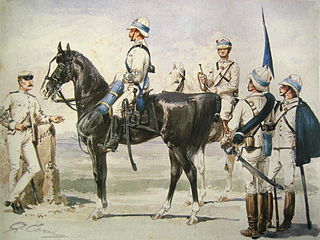 W
WThe Cacciatori d'Africa was a title given to Italian light infantry and mounted infantry units raised for colonial service in Africa.
 W
WThe Mino, or Minon, which means "our mothers", or so-called Dahomey Amazons by European writers, were a Fon all-female military regiment of the Kingdom of Dahomey in the present-day Republic of Benin which lasted until 1904. They were so named by Western observers and historians due to their similarity to the mythical Amazons of ancient Anatolia and the Black Sea.
 W
WDufile was originally a fort built by Emin Pasha, the Governor of Equatoria, in 1879; it is located on the Albert Nile just inside Uganda, close to a site chosen in 1874 by then-Colonel Charles George Gordon to assemble steamers that were carried there overland. Abandoned by Emin's people in January 1889, Dufile being within the Lado Enclave was reoccupied and reconstructed by Belgian forces from 1902 to 1907.
 W
WThe East African campaign in World War I was a series of battles and guerrilla actions, which started in German East Africa (GEA) and spread to portions of Portuguese Mozambique, Northern Rhodesia, British East Africa, the Uganda Protectorate, and the Belgian Congo. The campaign all but ended in German East Africa in November 1917 when the Germans entered Portuguese Mozambique and continued the campaign living off Portuguese supplies.
 W
WEuropean Union Force RCA, commonly referred as EUFOR RCA, is the United Nations-mandated European Union peacekeeping mission in Bangui, capital of the Central African Republic. The goal of the mission is to stabilize the area after more than a year of internal conflict. Agreement about the mission was reached in January 2014, and the first operations started at the end of April. The mission ended its mandate after nearly a year on 15 March 2015.
 W
WEuropean Union Force Chad/CAR, also EUFOR Tchad/RCA after the French, was the European Union mission in Chad and the Central African Republic (CAR), authorised in late 2007. EUFOR Chad/CAR was authorised under the same United Nations Security Council resolution that mandated MINURCAT, a UN force tasked with training police and improving judicial infrastructure.
 W
WThe Fashoda Incident was the climax of imperial territorial disputes between Britain and France in East Africa, occurring in 1898. A French expedition to Fashoda on the White Nile river sought to gain control of the Upper Nile river basin and thereby exclude Britain from the Sudan. The French party and a British-Egyptian force met on friendly terms, but back in Europe, it became a war scare. The British held firm as both empires stood on the verge of war with heated rhetoric on both sides. Under heavy pressure, the French withdrew, ensuring Anglo-Egyptian control over the area. The status quo was recognised by an agreement between the two states acknowledging British control over Egypt, while France became the dominant power in Morocco. France had failed in its main goals.Between the two governments there was a brief battle of wills, with the British insisting on immediate and unconditional French withdrawal from Fashoda. The French had to accept these terms, amounting to a public humiliation....Fashoda was long remembered in France as an example of British brutality and injustice.
 W
WThe First Franco-Dahomean War, which raged in 1890, was a conflict between France, led by General Alfred-Amédée Dodds, and Dahomey under King Béhanzin. The French emerged triumphant after winning the Battle of Abomey.
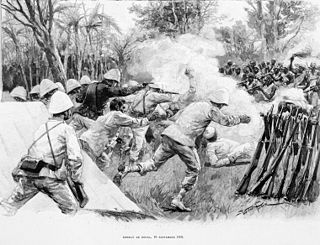 W
WThe Second Franco-Dahomean War, which raged from 1892 to 1894, was a major conflict between the French Third Republic, led by General Alfred-Amédée Dodds, and the Kingdom of Dahomey under King Béhanzin. The French emerged triumphant and incorporated Dahomey into their growing colonial territory of French West Africa.
 W
WNote:"Modern" is defined as post-WWI period, from 1918 until today. "North Africa" has a definition approximately that of the Arab term `Maghreb`. "Conflict" is defined as a separate 100+ casualty incident. In all cases conflicts are listed by total deaths, including subconflicts.
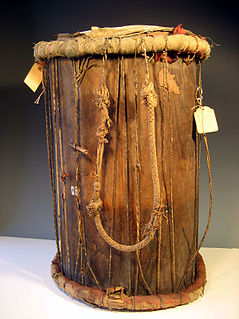 W
WThe Battle of Logandème was an uprising led by the Serer King Maad a Sinig Kumba Ndoffene Famak Joof, king of Sine, against the French Empire. The battle took place at Logandème which was a part of Sine at the time. The battle was also a revenge attack against the Serer people after their resounding victory against France at the Battle of Djilass on 13th May 1859. It was the first time that France decided to employ cannonball in the Senegambia.
 W
WNubia is a region along the Nile river encompassing the area between the first cataract of the Nile as well as the confluence of the blue and white Niles or, more strictly, Al Dabbah. Nubia was the seat of several civilizations of ancient Africa, including the Kerma culture, the kingdom of Kush, Nobatia, Makuria and Alodia.
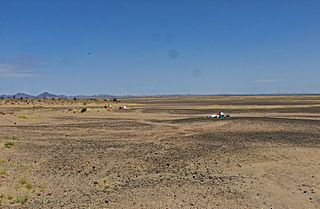 W
WNataruk in Turkana County, Kenya, is the site of an archaeological investigation which uncovered the 10,000-year-old remains of 27 people. The remains have garnered wide media attention for possible bioarchaeological evidence of interpersonal violence, i.e. prehistoric warfare.
 W
WThe Ottoman-Portuguese conflicts of 1538 to 1559 were a series of armed military encounters between the Portuguese Empire, the Kingdom of Hormuz, and the Ethiopian Empire against the Ottoman Empire and Adal Sultanate, in the Indian Ocean, the Persian Gulf, the Red Sea, and in East Africa. This is a period of battles in The Ottoman-Portuguese War.
 W
WThe Ottoman–Portuguese Conflicts (1586–1589) were armed military conflicts between the Portuguese Empire and the Ottoman Empire in the Indian Ocean, specifically in the east-African coast.
 W
WRuga-Ruga were irregular troops in Eastern Africa, often deployed by western colonial forces. They often served as mercenaries or local auxiliaries alongside the regular Askari, professional soldiers who were often hired in other regions of Africa. While the latter were trained by officers of the European colonial powers in Africa, the Ruga-Ruga were mostly hired from tribal warriors during times of conflict.
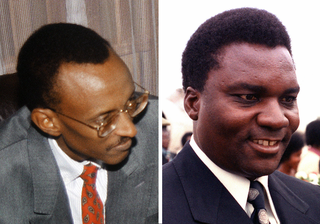 W
WThe Rwandan Civil War was a large-scale civil war in Rwanda fought between the Rwandan Armed Forces, representing the country's government, and the rebel Rwandan Patriotic Front (RPF) from 1 October 1990 to 18 July 1994. The war arose from the long-running dispute between the Hutu and Tutsi groups within the Rwandan population. A 1959–1962 revolution had replaced the Tutsi monarchy with a Hutu-led republic, forcing more than 336,000 Tutsi to seek refuge in neighbouring countries. A group of these refugees in Uganda founded the RPF which, under the leadership of Fred Rwigyema and Paul Kagame, became a battle-ready army by the late 1980s.
 W
WSamori Ture, also known as Samori Toure, Samory Touré, or Almamy Samore Lafiya Toure, was a Muslim cleric, a military strategist, and the founder and leader of the Wassoulou Empire, an Islamic empire that was in present-day north and south-eastern Guinea and included part of north-eastern Sierra Leone, part of Mali, part of northern Côte d'Ivoire and part of southern Burkina Faso. Samori Ture was a deeply religious Muslim of the Maliki jurisprudence of Sunni Islam.
 W
WUnited States Army Africa (USARAF), also known as the Southern European Task Force (SETAF), is the United States Army service component command of United States Africa Command.
 W
WThe Mediterranean and Middle East Theatre was a major theatre of operations during the Second World War. The vast size of the Mediterranean and Middle East theatre saw interconnected naval, land, and air campaigns fought for control of the Mediterranean, North Africa, the Horn of Africa, the Middle East and Southern Europe. The fighting in this theatre lasted from 10 June 1940, when Italy entered the war on the side of Germany, until 2 May 1945 when all Axis forces in Italy surrendered. However, fighting would continue in Greece – where British troops had been dispatched to aid the Greek government – during the early stages of the Greek Civil War.